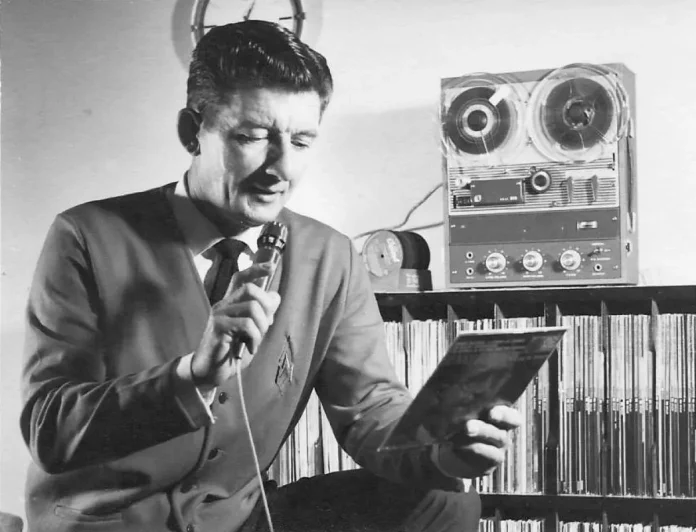The folk music of South Africa, like that of America, is as varied as its people. Just as the music jazz evolved from fragments of foreign musical cultures – foreign, that is, to the continent of North America – so did South African folk music arise from its visitors . . . they brought the rich Bantu rhythms and melodies from the north; the traditional Indian music of the Asian labourers who came to work in the sugar plantations; the mysterious airs of the Cape Malays and Coloureds and the popular songs and dances of the European settlers with English, Dutch and French predominating.
Jazz was once splendidly described (by Iain Lang in ‘Jazz In Perspective’) as the result of a black man trying to sing a white man’s tune, and we can all point to a well-loved jazz number that was originally an Elizabethan ballad, a French quadrille or a Belgian marching song. A South African example of this adoption is the melody of Sarie Marais, which came from America as Ellie Rhee and before that from England as The Foggy, Foggy Dew.
One of the most musical communities in South Africa is that of the Cape Coloureds, Creoles who descend from Asians brought to the Cape in the 17th century. New Year celebrations for them are akin to the New Orleans Mardi Gras as
10,000 Coioureds in high costume and strumming all kinds of stringed instruments – banjo, mandolin and guitar being the favourites – sing and dance through the streets for hours on end. These festivities have been known for years as Coon Carnivals and are so called by all races including the Coloured themselves.
Their music is as cosmopolitan as the country itself, as they sing European ballads – some of which are really ancient – love songs, drinking songs, political songs and the distinctive street songs (‘moppies’), which are musical slanging matches that sometimes reach the personal insult stage of the Negro ‘Dirty Dozens’.
The use of the great drums of Central and West African tribes never reached South Africa, which does not have large forests. Handclapping takes the place of drumming, although drums of animal hide are popular for tribal dancing and religious gatherings. The Bantu tribes are famous makers of music, the kind of music they make varying with their surroundings and the degree to which they have been exposed to outside influences. Musical instruments, available or lacking, also have a say in the nature of the music making and because of the rarity of natural woods, singing rather than instrumental playing forms the basic art.
High on the popularity list are the wedding and party songs, songs of the fighters (ihubo), riding songs (mokorotlo) and the ubiquitous lullaby. By far the more interesting are the tunes and songs composed by lone minstrels or groups of friends with accompaniment by battered guitars and cheap harmonicas and concertinas as they walk along dusty country roads or city streets or as they sit around the fire at night. Then there are the bands of urchins playing penny whistles in the townships or outside theatres for pennies. The Zulu work force is a migratory one – in fact one could say this of the Bantu nation as a whole – and they think nothing of walking from one town to another in the heat of day, untiring if accompanied by the sound of music. The transistor radio, tuned in to a Bantu station, is music in its most convenient form today.
As one sits in one’s house one often hears the soft tones of the Basuto housemaid as she stands ironing, her baby strapped to her back by a shawl. Her body moves in quiet, somnolent rhythm as she sings a lullaby that could well be centuries old. Even when the little one has dozed off and has been put down to sleep the mother will still sing softly to herself as she smoothes the clothes. Much use is made of falsetto, popular with blues singers.
Her husband might be in a gang of municipal workers digging a road-trench for some cable laying, making the work easier – as the first Afro-Americans did – by singing a worksong, using the familiar call-and-response pattern to synchronise the bite of the picks into the tarmac. To see this and to hear it is just fascinating. It’s all done in the native tongue and it is common knowledge that choice remarks concerning the white onlookers are often incorporated! (Now, don’t tell me they read all the books on slavery in the Deep South!)
At weekends, mostly Sunday afternoon, the Church of Zion – ‘Bush Baptists’ – meets on a patch of waste ground in their blue and white robes. The drums throb, the disciples yell and stomp around in a circle as the preacher man in the centre shakes seven kinds of devils and all hell out of an initiate who at that moment is no doubt wishing he’d stayed at home. On the other side of town, in a mean mud church, another sect, suitably robed and toting crosses and crooks, shuffles around in a holiness dance – the original ring-shout. Further up the religious scale is the Bantu Full Gospel Church, complete with frenzied handclapping and foot-stomping and tambourine rattling to the rhythmic hymns – and what fabulous natural harmonies swing from those happy throats. Makes one wonder if they’ve ever heard of the Rev. Kelsey.
You know, come to think of it, South Africans are probably closer to the origins of jazz than the Americans and are hearing it as it was long before the Sunday sessions in Congo Square. In fact, it wouldn’t be so hard to contradict the history books and come right out and say it . . . jazz began on my doorstep.
















